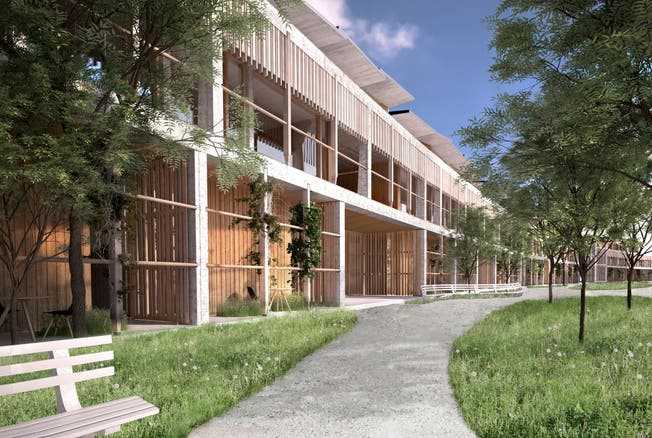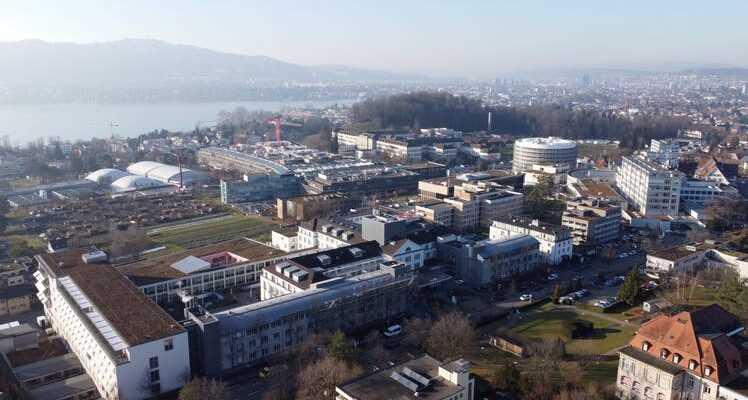One of the largest hospital landscapes in Europe is developing on the outskirts of District 8. The institutions are now setting the course for a joint climate-neutral supply of heating and cooling.
The health facilities in Lengg with the Hirslanden Clinic in the foreground and the Balgrist (on the right). The construction site of the Kispi and the Burgholzli can be seen behind the Schulthess Clinic in the middle.
Andrea Rytz’s primary task is to lead a large hospital operation to success in a competitive environment so that her patients can go through life pain-free. Recently, the Director of the Schulthess Clinic in Zurich has also been working on a climate-neutral energy supply.
Rytz is the president of the Lengg health cluster, Europe’s largest innovation area in the health sector. In 2016, the most important institutions between Rehalp and Tiefenbrunnen joined forces in the association. In addition to Schulthess and the Hirslanden clinic, it also includes the Balgrist orthopedic university clinic, the psychiatric university clinic and the Swiss Epilepsy Foundation. The University Children’s Hospital (Kispi), which will move from the Zürichberg to its new building in the middle of the Lengg area in 2024, is also there, as is the Mathilde Escher Foundation, a social facility for people with disabilities.
The focus of the cooperation is the transfer of knowledge from research and teaching as well as cooperation in medical services. But also the sustainable management of the infrastructure: in a few years, the institutions of the health cluster are to be supplied with heating, hot water and also cooling via a joint energy network. “Without close cooperation, this would not be possible,” says Rytz in her office with a view of the new children’s hospital and the lake. It will serve as an energy source in the future.
Lake Zurich is not just a destination, a (drinking) water reservoir for the region and a large bathtub in summer. It also serves as a huge reservoir of heat – or cold, as needed. Using your water to generate energy using heat pumps is nothing new. There are already several lake water networks in Zurich, and the NZZ buildings have also been heated in this way since 2008.
This concept is to be expanded on a large scale throughout the city. A year ago, the city council announced that by 2040 around 60 percent of the settlement area should be developed via district heating and heating networks. Investments of around CHF 1.5 billion are planned for this. It is one of the most important steps towards the goal of reducing greenhouse gas emissions from the combustion of fossil fuels in the city of Zurich to almost zero. The hospitals and clinics in Lengg are planning the next energy network, which will be the largest of its kind.
Economical and climate neutral
The health cluster is also of economic importance for Zurich. It generates sales of CHF 1.3 billion and employs over 9,000 people. With the relocation of the Kispi, these numbers have risen significantly again, other institutions want to expand. The development also prompted the canton to play a coordinating role. In the Lengg master plan from autumn 2017, the energy supply based on lake water was recommended.
“When we decided to do it, it looked as if we would have to top it,” says Andrea Rytz. In view of the currently drastically rising prices for oil and gas, it is no longer just the optimal solution from an ecological point of view, but also from an economic point of view: “But it was always clear to us that we would strive for a sustainable energy supply together with all institutions.”
The network is built by Energie 360°. The municipal company later invoices the useful energy used. The planning application was submitted at the end of March in Zollikon. Reason: The lake water center with the heat exchanger is sunk into the lake shore on the Zolliker Areal Wäßig. It consists of an underground, cylindrical shaft that is over 20 meters high and has a diameter of a good 15 meters. From here, the lake water is collected at a depth of 25 to over 30 meters and pumped through a 2 meter thick tube deep in the ground over a considerable difference in height through the Molasse rock into the Lengg area.
The Wäßerig location is given symbolic importance. Coal was once unloaded here from transport ships, the energy of the past. Zollikon benefits from making the space available. Residential houses and settlements in its municipal area can also be connected to the Seewasserverbund. The project makes it possible to save around the equivalent of 4 million liters of oil every year; According to information from Energie 360°, this corresponds to a reduction in CO2-emissions by about 10,000 tons.
For the further distribution network and the processing of the energy, the customers must also contribute their part to the investments totaling around 70 million Swiss francs. The responsible bodies of the health institutions are currently deciding whether to participate. The energy supply contract is to be signed this year. If that is the case, construction work will start in 2023 and the lake water network can be put into operation in 2026. The fact that hardly anyone doubts this is shown by the fact that Energie 360° is currently making preliminary investments for the future distribution network in the ground next to the new Kispi building.
Corona promotes mutual trust
For the Schulthess CEO Andrea Rytz, the lake water network does not only come at the right moment in terms of energy. “It makes you want to work even more together,” she says. Although the clinics are sometimes in competition with each other, they are looking for cooperation in a wide variety of areas. Rytz notes that it is important to exchange information with one another on a regular basis, to know what the others are doing and to learn to develop blind trust. This has proven its worth in the last two years, when the hospitals worked very intensively together during the corona pandemic.
The directors meet regularly and look for possible synergies, says Rytz, and cites the sharing of office space, seminar rooms, cleaning and processing systems or coordinated delivery as project ideas in order to reduce truck journeys. Another current example: The Kispi connects its new building to the power grid via two different substations. Although this does not replace an emergency power generator that is indispensable for hospitals, it does increase the security of supply. Thanks to the health cluster, other institutions could easily join this solution.

The new children’s hospital by Herzog & de Meuron will present itself as in this visualization.
A big topic in Lengg is traffic. A significant increase in traffic is expected by 2040. Accompanying measures are necessary to cope with the increase. The VBZ are planning a new bus route through the area, and the number 15 tram will one day go as far as Rehalp. A further expansion of public transport is not in sight for the time being. The government council recently ruled out an underground route for the Forchbahn between Zollikerberg and Rehalp because of costs of around 800 million francs.
On the other hand, the cantonal council has limited the number of car trips to 11,600 in the structure plan. Employees are encouraged to use public transport with discounts. The cluster is also helpful for this. “Together it is possible to negotiate more favorable conditions for the employees,” says Rytz. In the future, good reasons will be needed to be able to drive to work in the Lengg. These should not depend on professional status, and even a chief physician is not simply entitled to a parking space. But about disabled employees or who has to take a child to care.
Don’t forget compatibility
Andrea Rytz’s door is open. It is important to her not to concoct anything in secret. This is appreciated in the district, but the growth of the clinics is also met with skepticism. Before the summer holidays, several information events will take place together with representatives of the canton. Urs Frey, President of the Riesbach District Association, says they were onlookers during the test planning and were listened to.
Three concerns are paramount for the residents: first and foremost, the containment of additional traffic. Frey finds the cap at 11,600 journeys correct and good. Then there is the urban planning: the view of the unique Burgholzli landscape and the mountains should not be obstructed. Ultimately, the Lengg must be preserved and remain accessible as a green recreation area with family gardens and sports facilities for the district.
It is important that the expansion in the Lengg also has added value, says Frey. Up until now, there has been a lot of talk about feasibility, but the main thing is tolerability. After all, any differences between the clinics and the district affect the surface. A power supply underground hardly encounters any resistance.
